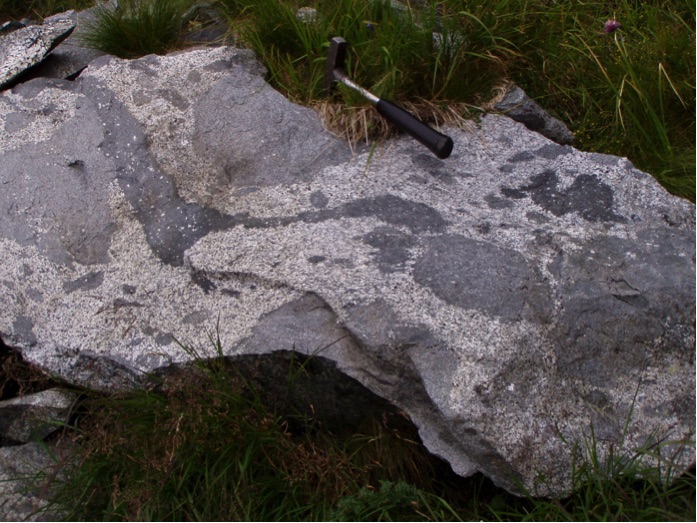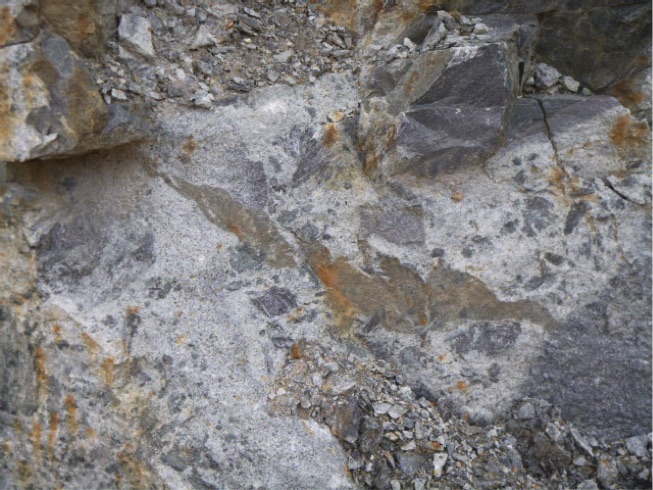Timing and tempo of magmatism in the crust
A growing body of evidence supports the notion that plutons are incrementally assembled by repeated magma injections and eventually build up batholiths over extended periods of time. Timescales of pluton construction vary from 104 to 106 years. Using high precision, chemical abrasion, isotope dilution thermal ionization mass spectrometry (CA-ID-TIMS) U-Pb zircon geochronology it is possible to resolve individual magma pulses and to track both the thermal and crystallization histories of magmatic systems at high temporal resolution.
During periods of repeated magma injections, temperature, crystal content and composition will fluctuate within magma batches, and conditions potentially alternate between zircon saturation and undersaturation, which will lead to intermittent periods of crystallization and resorption/partial dissolution. Following episodes of reheating and rejuvenation, zircon dates will record periods of enhanced zircon crystallization associated with cooling below the maximum temperature of zircon saturation. This is reflected by a distinct mode in U-Pb age distribution curves and translates into an increased proportion of zircon crystals of a similar age in individual magma batches (Broderick et al., 2015; Wotzlaw et al., 2012). High-precision CA-ID-TIMS dating techniques applied to zircon have the potential to resolve the periodicity of temperature fluctuations in a magmatic system at lower or intermediate crustal levels over the time interval the magma remained zircon saturated. However, such dates are obtained from whole zircon grains or grain fragments and are potentially integrated over complex and protracted growth histories. Spatially resolved U-Pb dates on the other hand, do not offer the necessary 10 to 100 ka precision for resolving the timing of magmatic processes in most pre-Pleistocene systems.
U-Pb age distribution curves (probability density curves) may be used to model the volume and integrated magma flux of a magmatic system, see our Nature paper Caricchi et al. (2014, 2016). The timing of magmatism also has tremendous implications for the style and timescales of magmatic-hydrothermal ore deposits (Chiaradia et al., 2013). In order to quantify magmatic processes further, we apply trace element chemical analyses both in-situ before, and in solution after dissolution of the zircon, as well as Hf isotope analysis.
The timing of orogenic magmatism has been studied in detail in the frame of several case studies in the last years:
A) Adamello research program 2009-2014 (see Schaltegger et al., 2009; Schoene et al., 2012; Broderick et al., 2015; Schaltegger et al., 2019): The Adamello intrusive suite was emplaced into the upper crust within 10 myr and is composed of single, so-called super-units spanning 1-2 myr emplacement duration. High-precision U-Pb dating in he southern part (southern Rè di Castello unit) evidenced the existence of sub-units reording zircon crystallization over 300 kyr. The melt source moved from SW to NE over the entire time span and was increasingly assimilating crustal material recorded in zircon O and Hf isotope compositions (Schaltegger et al. 2019). Zircon crystallization is thought to be ± continuous in a mid-crustal magma storage area and the present-day outcrop relationships are created by multiple pulses of magma emplacing together with their crystal cargo in the upper crust.

Mixing and mingling of different magmas during the emplacement of the 42.5 Ma old Val Fredda complex in the southern Adamello batholith (N. Italy)
B) Yellowstone hotspot magmatism (Wotzlaw et al., 2013, 2014, 2015): The work showed how small magma batches with different composition, different degrees of crustal contamination and different fractional crystallization history co-exist at different levels of the crust. The coalescence of these reservoirs across the crustal scale plumbing system leads to overpressure and super-eruption. Large magma systems such a s the Fish Canyon Tuff show coherent fractional crystallization trends pointing to a homogeneous, convecting magma system before eruption. The FCT super-eruption was triggered through rejuvenation by a hot magma recharge, after the magma reservoir has been solidified up to 80 vol.%.
C) The timescales of melting, melt migration, fractional crystallization and emplacement of crustal peraluminous melts were part of the research of H2020-MSC fellow Federico Farina. He focuses on granitoid magmatism issued from melting of metasedimentary crust in the Larderello-Travale area (Tuscany, Italy). These 1 to 4 myr old granites are underlying a presently active geothermal system (Farina et al., 2018). We also work on the timescales of melting and melt reactions, investigating the U-Pb systematics of monazite and xenotime in 325 Ma old migmatites and granites of the Bohemian massif, and on high-T/high-P deep crustal melts in granulites of the Czech Republic.

Various phases of melting and crystallisation recorded in migmatites of a quarry in Moldanubian gneisses of the Bohemian Massif.
D) Timescales of zircon growth in mafic magmatic rocks (Davies et al., submitted): zircon is a late phase in the crystallization sequence of a basaltic-tholeiitc melt. It is supposed to cryszallize among the mast 10% od residual melt, which will be saturated in feldspars, quartz and zircon. The saturation and precispitation is supposedly instantaneous, contradicting excess variance in zircon ages from dolerites of Large Igneous Provinces. Watch out for Davies et al. to be published soon!!!
Selected papers:
Broderick C., Wotzlaw J.-F., U., Frick D., Gerdes A., Günther D. & Schaltegger U. (2015) Linking the thermal evolution of an upper crustal intrusion to its lower-crustal roots using zircon and titanite geochronology and geochemistry (Southern Adamello batholith, N. Italy). Contrib. Mineral. Petrol 170, 28
Chiaradia M., Schaltegger U., Spikings R., Wotzlaw J.-F. & Ovtcharova M. (2013) How accurately can we date the duration of magmatic-hydrothermal events in porphyry systems? - An invited paper. Econ. Geology 108/4, 565-584
Caricchi L., Simpson G. & Schaltegger U. (2014) Zircons reveal magma fluxes in the Earth’s crust. Nature 511, 457-461
Caricchi L., Simpson G. & Schaltegger U. (2016) Estimates of volume and magma input in crustal magmatic systems from zircon geochronology: the effect of modelling assumptions and system variables. Front. Earth Sci., doi: 10.3389/feart.2016.00048
Farina F., Dini A., Ovtcharova M., Davies J., Greber N.D., Bouvier A.-S., Baumgartner L., Ulyanov A. & Schaltegger U. (2018) Zircon petrochronology reveals the mechanism of crustal anatectic magma formation. Earth Planet. Sci. Lett., 495, 213-223
Schaltegger U., Brack P., Ovtcharova M., Peytcheva I., Schoene B., Stracke A. & Bargossi G. (2009) Zircon and titanite recording 1.5 million years of magma accretion, crystallization and initial cooling in a composite pluton (southern Adamello batholith, northern Italy) Earth Planet. Sci. Lett. 286, 108-218
Schaltegger U., Nowak A., Ulianov A., Fisher C.M., Gerdes A., Spikings R., Whitehouse M., Bindeman I.N., Brack P., Hanchar J., Duff J., Vervoort J.D., Sheldrake T., Caricchi L. & Müntener O. (2019) Zircon petrochronology and 40Ar-39Ar thermochronology of the Adamello intrusive suite, N-Italy: monitoring the growth and decay of an incrementally assembled magmatic system. J. Petrol. 60, 701-722
Wotzlaw J.F., Bindeman I.N., Schaltegger U., Brooks K.C., Naslund H.R. & Gerdes A. (2012) Zircon records crystallization, hydrothermal alteration and remelting in the Skaergaard intrusive complex. Earth Planet. Sci. Lett. 355–356, 199–212
Wotzlaw J.F., Bindeman I.N., Stern R.A., D'Abzac F.-X. & Schaltegger U. (2015) Rapid heterogenous assembly of multiple magma reservoirs prior to Yellowstone supereruptions. Sci. Rep. 5, 14026, doi:10.1038/srep14026
Wotzlaw J.F., Bindeman I.N., Watts K.E., Schmitt A.K., Caricchi L. & Schaltegger U. (2014) Linking rapid magma reservoir assembly and eruption trigger mechanisms at evolved Yellowstone-type supervolcanoes. Geology 42, 807-810
Wotzlaw J.-F., Schaltegger U., Frick D.A., Dungan M.A., Gerdes A. & Günther D. (2013) Tracking the evolution of large volume silicic magma reservoirs from assembly to supereruption. Geology 41, 867-870
